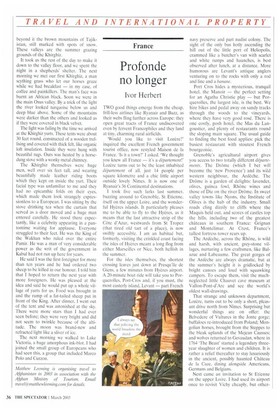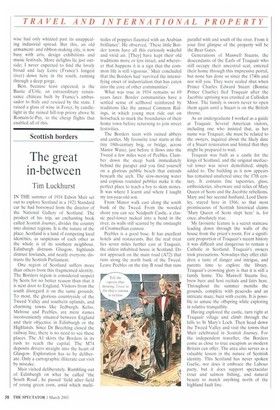France
Profonde no longer
Ivor Herbert
TWO good things emerge from the cheap, frill-less airlines like Ryanair and Buzz, as their webs fling further across Europe: they open great tracts of France undiscovered even by fervent Francophiles and they land at tiny, charming rural airfields.
'Would you like to visit Lozere?' inquired the excellent French government tourist office, now restyled Maison de la France. 'Is it a town?' I asked. 'We thought you knew all France — it's a departement!' Lozere turns out to be the least inhabited departement of all, just 14 people per square kilometre and a chic little airport outside lovely Nimes. It is now one of Ryanair's 36 Continental destinations.
I took five such larks last summer, buzzing around to Grenoble, St Etienne. itself on the upper Loire, and the wonderful Hyeres islands. It particularly pleases me to be able to fly to the Hyeres, as it means that the last attractive strip of the COte d'Azur, westwards from St Tropez (that tired old tart of a place), is now swiftly accessible. I am an habitué but, formerly, visiting the crinkled coast facing the isles of Hyeres meant a long flog from either Marseilles or Nice, both hellish in the summer.
For the isles themselves, the shortest crossing leaves just down at Presqu'ile de Giens, a few minutes from Hyeres airport. A 20-minute boat ride will take you to Porquerolles, Port-Cros and, if you must, the most easterly island, Levant — part French navy preserve and part nudist colony. The sight of the only bus hotly ascending the hill out of the little port of Heliopolis, crammed like a butcher's van with scarlet and white rumps and haunches, is best observed after lunch, at a distance. More humorous are Levant's antique anglers venturing on to the rocks with only a rod and line and a banane.
Port Cros hides a mysterious, tranquil hotel, the Manoir — the perfect setting for an Agatha Christie play — but Porquerolles, the largest isle, is the best. We hire bikes and pedal away on sandy tracks through the woods to the vineyards, where they have very good rosé. There is one costly, posh hotel, the Mas du Langoustier, and plenty of restaurants round the sloping main square. The usual guide to finding the best food applies: pick the busiest restaurant with stoutest French bourgeoisie.
Grenoble's agricultural airport gives you access to two totally different departements. The Drome (which I bet will become the 'new Provence') and its wild western neighbour, the Ardeche. The Dame is a garden of delights: lavender, olives, guinea fowl, Rhone wines and those of Die on the river Drome. In sweet valley towns like Nyons, the Institute of Olives is the hub of the industry. Small roads cling dizzily to cliffs where the Maquis held out, and scores of castles top the hills, including two of the greatest châteaux in southern France: Grignan and Montelimar. At Crest, France's tallest fortress tower rears up.
The Ardeche, across the Rhone, is wild and harsh, with ancient, grey-stone villages, nurturing a few craftsmen, like Balazuc and Labeaume. The great gorges of the Ardeche are always dramatic, but at the summer's height it is gridlocked by bright canoes and loud with squawking campers. To escape them, visit the muchneglected little Chauvet cave museum at Vallon-Pont-d'Arc and see the world's oldest wall-drawings.
That strange and unknown department, Lozere, turns out to be only a short, pleasant drive north from Nimes. Surprising but wonderful things are on offer: the Belvedere of Vultures in the Jonte gorge; buffaloes re-introduced from Poland; Mongolian horses, brought from the Steppes to the bleak uplands of the Mejean Causses; and wolves returned to Gevaudan, where in 1764 'The Beast' started a legendary threeyear slaughter of women and children. It is rather a relief thereafter to stay luxuriously in the ancient, possibly haunted Chateau de la Caze, dining alongside Americans. Germans and Belgians.
Next came an invitation to St Etienne on the upper Loire. I had used its airport once to revisit Vichy cheaply, but other wise had only whizzed past its unappealing industrial spread. But this, an old armamentand ribbon-making city, is now busy with arts, design exhibitions and music festivals. More delights lie just outside; I never expected to find the lovely broad and lazy Loire (France's longest river) down here in the south, running through a deep gorge.
Best, because least expected, is the Bastie d'Urfe, an extraordinary renaissance château built by France's ambassador to Italy and rescued by the state. I raised a glass of wine in Forez, by candlelight in the ruined hill-top priory above St Romain-le-Puy, to the cheap flights that enabled all of this.



















































































 Previous page
Previous page